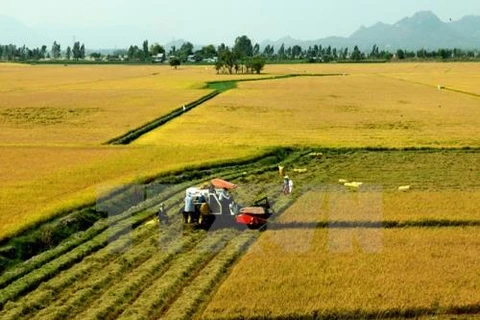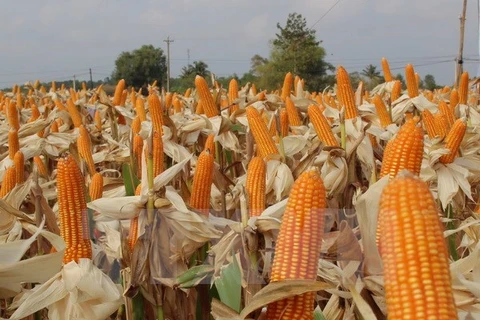Kon Tum (VNA) - In a remote commune populated by Xe Dang ethnic group in the Central Highlands province of Kon Tum, many villages have become prosperous by creating large fields for modern farming.
A Vinh, deputy chairman of the People’s Committee of Mang But commune in Kon Plong district, boasted that nowhere else can one find such productive corn fields.
In his upland commune, corn plants grow as well as in the silted fields of the deltas, he said.
Most fields in this area were left fallow for a long time before corn was grown on them on the instruction of local authorities.
It took time for Mang But commune authorities to convince locals to grow corn plants because the ethnic people had never grown the crop before.
But the campaign finally won farmers over when they saw the stems of the corn plants being sold at high prices right at the farm after harvest.
“We don’t have to carry the corn trunks to the main road for sales as done when selling cassava,” A Toan, a local farmer said. “It’s much easier.”
A Hao, another Mang But farmer, said many large paddy fields in the area had been left uncultivated because of low productivity. But corn plants grow well on the soil, which is suitable for them, he said.
A Vinh, also a farmer, said locals grew corn on 20ha of land in the villages of Mang But and Long Rua. The Kon Plong district-based Mang Den Pharmaceutical and Food Co. provided them with seeds and technical support, and pledged to buy their entire output.
“After the first bumper crop, in the second year Xe Dang farmers themselves sought seeds and technical know-how for growing corn.”
According to Vo Dinh Viet, head of the Kon Plong district Division of Agriculture and Rural Development, the two large corn fields cultivated by the Xe Dang are the first of their kind in the district. Their entire output is bought by the Mang Den Company, he said.
The commune’s farmers cultivate 20ha of land, but with the company planning to breed 10,000 goats, the area would expand, he said.
The company provides funds for the farming and is repaid following harvest.
The farmers only need to farm as they are told, Viet said.
According to local farmers, a hectare yields 25-35 tonnes of corn stems per crop, and fetches 25-35 million VND. They grow three crops a year.
No other crop can match corn in terms of yield on this land, Viet said.
Nguyen Van Lan, chairman of the Kon Plong district People’s Committee, said district authorities have made efforts to develop large parcels of land to grow crops on a large scale together with pledges from companies to buy their produce.
Following the success of the model, Kon Plong district plans to create fields of 800-2,000ha for large-scale production by 2020, Lan said.
“We have to act as a link between farmers and enterprises, helping farmers sign purchase and consumption contracts with them,” he said.-VNA
In his upland commune, corn plants grow as well as in the silted fields of the deltas, he said.
Most fields in this area were left fallow for a long time before corn was grown on them on the instruction of local authorities.
It took time for Mang But commune authorities to convince locals to grow corn plants because the ethnic people had never grown the crop before.
But the campaign finally won farmers over when they saw the stems of the corn plants being sold at high prices right at the farm after harvest.
“We don’t have to carry the corn trunks to the main road for sales as done when selling cassava,” A Toan, a local farmer said. “It’s much easier.”
A Hao, another Mang But farmer, said many large paddy fields in the area had been left uncultivated because of low productivity. But corn plants grow well on the soil, which is suitable for them, he said.
A Vinh, also a farmer, said locals grew corn on 20ha of land in the villages of Mang But and Long Rua. The Kon Plong district-based Mang Den Pharmaceutical and Food Co. provided them with seeds and technical support, and pledged to buy their entire output.
“After the first bumper crop, in the second year Xe Dang farmers themselves sought seeds and technical know-how for growing corn.”
According to Vo Dinh Viet, head of the Kon Plong district Division of Agriculture and Rural Development, the two large corn fields cultivated by the Xe Dang are the first of their kind in the district. Their entire output is bought by the Mang Den Company, he said.
The commune’s farmers cultivate 20ha of land, but with the company planning to breed 10,000 goats, the area would expand, he said.
The company provides funds for the farming and is repaid following harvest.
The farmers only need to farm as they are told, Viet said.
According to local farmers, a hectare yields 25-35 tonnes of corn stems per crop, and fetches 25-35 million VND. They grow three crops a year.
No other crop can match corn in terms of yield on this land, Viet said.
Nguyen Van Lan, chairman of the Kon Plong district People’s Committee, said district authorities have made efforts to develop large parcels of land to grow crops on a large scale together with pledges from companies to buy their produce.
Following the success of the model, Kon Plong district plans to create fields of 800-2,000ha for large-scale production by 2020, Lan said.
“We have to act as a link between farmers and enterprises, helping farmers sign purchase and consumption contracts with them,” he said.-VNA
VNA
























